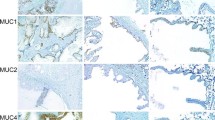Abstract
Differentiation of salivary gland acinic cell carcinoma from mucoepidermoid carcinoma can be diagnostically challenging as both may have prominent mucin production. P63 is a p53 homologue required for limb and epidermal morphogenesis. It is expressed in basal and myoepithelial cells of normal salivary gland tissues. In this immunohistochemical study, we examined the expression of p63 in salivary gland acinic cell and mucoepidermoid carcinomas (MEC) and its use in differentiating these two entities. A search was performed and appropriate cases were selected from Lifespan Hospital System archives as well as the consult archives of one author (DRG). 31 salivary gland acinic cell carcinomas (ACC) and 24 MEC were examined for p63 expression by immunohistochemistry. The nuclear immunoreactivity was examined by both authors and was graded semi-quantitatively with negative being less than 10 % of cells staining. Positive staining was graded as follows: 10–25 % of tumor cells staining was weakly positive, 26–75 % of tumor cells staining was moderately positive, and 76–100 % of tumor cells staining was strongly positive. Negative nuclear staining of the tumor cells was seen in 30/31 (96 %) of salivary gland ACC while 1/31 (3 %) showed diffuse nuclear staining of the tumor cells. This latter case was later reclassified as mammary analogue secretory carcinoma following confirmatory molecular testing for the ETV6-NTRK3 fusion gene. Strong positive nuclear staining of the tumor cells was seen in 24 (100 %) of salivary gland MEC cases. P63 is an immunohistochemical stain that can potentially aid in differentiating unusual ACC with prominent mucin production from MEC of the salivary gland. According to this study, acinic cell carcinoma is always negative for p63 immunoreactivity while mucoepidermoid carcinoma is always positive.



Similar content being viewed by others
References
Mills AA, Zheng B, Wang X-J, Vogel H, Roop DR, Bradley A. p63 is a p53 homologue required for limb and epidermal morphogenesis. Nature. 1999;398:708–13.
Yang A, Kaghad M, Caput D, McKeon F. On the shoulders of giants: p63, p73 and the rise of p53. Trends Genet. 2002;18:90–5.
Guo X, Keyes WM, Papazoglu C, Zuber J, Li W, Lowe SW, Vogel H, Mills AA. Tap63 induces senescence and suppresses tumorigenesis in vivo. Nat Cell Biol. 2009;12:1451–7.
Yang A, Kaghad M, Wang Y, Gillett E, Fleming MD, Dötsch V, Andrews NC, Caput D, McKeon F. p63, a p53 homolog at 3q27-29, encodes multiple products with transactivating, death-inducing, and dominant-negative activities. Mol Cell. 1998;3:305–16.
Bilal H, Handra-Luca A, Bertrand J-C, Fouret PJ. p63 is expressed in basal and myoepithelial cells of human normal and tumor salivary gland tissues. J Histochem Cytochem. 2003;51:133–9.
Weiler C, Reu S, Zengel P, Kirchner T, Ihrler S. Obligate basal cell component in salivary oncocytoma facilitates distinction from acinic cell carcinoma. Pathol Res Practice. 2009;205(12):838–42.
Ellis G, Simpson RHW. Acinic Cell Carcinoma. In: Eveson JW, Reichart P, Sidransky D, Barnes L, editors. World health organization classification of tumours. Pathology and genetics of head and neck tumours. Lyon: IARC Press; 2005. p. 216–8.
Goode RK, El-Naggar AK. Mucoepidermoid Carcinoma. In: Eveson JW, Reichart P, Sidransky D, Barnes L, editors. World health organization classification of tumours. Pathology and genetics of head and neck tumours. Lyon: IARC Press; 2005. p. 219–20.
Skálová A, Vanecek T, Sima R, Laco J, Weinreb I, Perez-Ordonez B, Starek I, Geierova M, Simpson RHW, Passador-Santos F, Ryska A, Leivo I, Kinkor Z, Michal M. Mammary analogue secretory carcinoma of salivary glands, Containing the ETV6-NTRK3 fusion gene: a hitherto undescribed salivary gland tumor entity. Am J Surg Pathol. 2010;34:599–607.
Gnepp DR, Henley JD, Simpson RHW, Eveson J. Salivary and Lacrimal Glands. In: Gnepp DR, editor. Diagnostic surgical pathology of the head and neck. Philadelphia: PA; 2009. p. 471–2.
Meer S, Altini M. CK7 +/CK20- immunoexpression profile is typical of salivary gland neoplasia. Histopathology. 2007;51:26–32.
Weinreb H, Seethala RR, Perez-Ordoñez B, Chetty R, Hoschar AP, Hunt JL. Oncocytic mucoepidermoid carcinoma clinicopathologic description in a series of 12 Cases. Am J Surg Pathol. 2009;33:409–16.
Hamper K, Schmitz-Wätjen W, Mausch H-E, Caselitz J, Seifert G. Multiple expression of tissue markers in mucoepidermoid carcinomas and acinic cell carcinomas of the salivary glands. Virchows Arch A Pathol Anat Histopathol. 1989;414:407–13.
Author information
Authors and Affiliations
Corresponding author
Rights and permissions
About this article
Cite this article
Sams, R.N., Gnepp, D.R. P63 Expression Can Be Used in Differential Diagnosis of Salivary Gland Acinic Cell and Mucoepidermoid Carcinomas. Head and Neck Pathol 7, 64–68 (2013). https://doi.org/10.1007/s12105-012-0403-2
Received:
Accepted:
Published:
Issue Date:
DOI: https://doi.org/10.1007/s12105-012-0403-2




